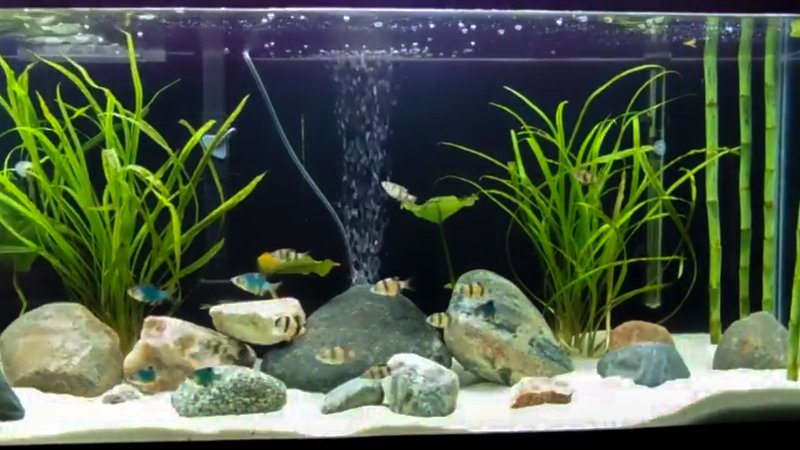
When you dive into the world of freshwater barbs, you might come across various types like Tiger Barbs, Cherry Barbs, or Odessa Barbs. Each type has its unique charm and requirements. But don’t worry! In this guide, we’ll break down everything you need to know—from water conditions to feeding and social interactions. So grab your coffee, and let’s jump into this colorful adventure!
Understanding the Basics of Barbs
Barbs are hardy freshwater fish that belong to the family Cyprinidae. These fish are known for their vibrant colors and playful personalities, making them a favorite among aquarium enthusiasts. You might be wondering what makes barbs so special. Well, it’s their social nature! They thrive in groups and love to dart around the tank, creating a lively environment.
Most barbs are relatively easy to care for, but they do have specific needs. For instance, water temperature should ideally be between 75°F and 82°F. They prefer slightly acidic to neutral pH levels, around 6.0 to 7.5. Keeping these parameters stable is crucial for their health. If you’re new to fishkeeping, it helps to invest in a good water testing kit. This way, you’ll ensure your barbs are living in a comfortable environment, just like setting the right mood for a fun gathering.
Setting Up the Perfect Habitat
Creating a suitable habitat for your barbs is key to their well-being. Think of it as designing a cozy home where they can feel safe and happy. Here are some essential elements to consider:
- Aquarium Size: Barbs are active swimmers, so a tank of at least 20 gallons is a good choice. This gives them enough space to explore.
- Decorations: Adding plants and hiding spots can help barbs feel secure. Silk or live plants are great options, as they also improve water quality.
- Substrate: A fine gravel or sand substrate is ideal. It won’t irritate their delicate barbels and makes it easier to maintain the tank.
Once you have the basics set up, make sure to cycle your tank before introducing your barbs. Cycling establishes beneficial bacteria that help break down waste, keeping the water clean and safe for your fish. It’s like opening the windows to let fresh air in—your barbs will appreciate it!
Choosing Tank Mates for Your Barbs
Barbs are known for their friendly and schooling behavior, but they can also be a bit feisty. When selecting tank mates, aim for species that can handle their playful nature. Here are some good options:
- Tetras: Many tetras are small and quick, which makes them great companions.
- Guppies: These colorful fish thrive in community tanks and can keep up with barbs’ energetic swimming.
- Other Barbs: Mixing different species of barbs can be a fun and visually appealing idea. Just ensure they’re all compatible.
You might want to avoid larger fish or those known to be aggressive. Barbs are curious and can sometimes nip at fish with long fins, which can lead to stress or injury. Keeping a balanced community will ensure a harmonious aquarium environment.
Feeding Barbs: What They Love
Feeding your barbs can be one of the most enjoyable aspects of caring for them. These fish are omnivorous, which means they eat both plant and animal-based foods. Here’s how to make mealtime exciting:
– Quality Flakes or Pellets: A good staple diet is high-quality flake or pellet food formulated for tropical fish. Look for options rich in protein to keep your barbs healthy.
– Live or Frozen Foods: Treating your barbs with live or frozen foods like brine shrimp or daphnia can stimulate their hunting instincts and provide essential nutrients.
– Vegetables: They also enjoy blanched vegetables like zucchini or peas, which can help with digestion.
Remember to feed them small portions two to three times a day. It’s better to offer less food and let them eat it all than to overfeed, which can lead to poor water quality. Think of it like serving snacks at a party—too much can create a mess!
Maintaining Water Quality
Water quality is crucial for your barbs’ health, much like a clean kitchen is essential for cooking a good meal. Here are some tips to keep your water in tip-top shape:
1. Regular Testing: Use a water testing kit weekly. This way, you can monitor pH, ammonia, nitrite, and nitrate levels. Stable water parameters help keep your fish stress-free.
2. Water Changes: Aim for a 25% water change every two weeks. This will dilute any toxins and replenish essential minerals.
3. Filtration: A good filter is your best friend! It helps remove waste and keeps the water moving. You want to aim for a filter that provides good circulation without creating strong currents, as barbs prefer gentle flow.
By keeping the water clean and well-oxygenated, you’re creating an environment where your barbs can thrive—much like enjoying a refreshing dip in a clean pool.
Health and Common Issues
Even healthy fish can encounter problems from time to time. Keeping an eye on your barbs can help you catch issues early. Here’s what to look out for:
– Behavior Changes: If your barbs are hiding or not swimming around, they might be stressed or sick. Look for signs of illness, like discoloration or frayed fins.
– Ich (White Spot Disease): This common parasite can affect barbs. Look for tiny white spots on their bodies. If you see these, a treatment with medicated solutions is often necessary.
– Swim Bladder Disorder: If a fish is floating sideways or has trouble swimming, it may have a swim bladder issue. This can sometimes be corrected with fasting or feeding a high-fiber diet.
Always remember, prevention is the best medicine. Keep your tank clean, and provide a balanced diet to minimize health issues. It’s like ensuring your friends have a good time at your party—keeping them happy means fewer problems later!
Regular Maintenance and Care
Caring for barbs isn’t just about setting up the tank; it’s a continuous process. Routine maintenance ensures your aquarium remains a lively and healthy environment. Here are some key tasks to incorporate:
– Check Equipment: Regularly test your filters, heaters, and lights to ensure they’re working effectively. A breakdown can lead to larger issues, like temperature fluctuations or poor water quality.
– Clean the Tank: Remove algae and debris, but be careful not to disturb the beneficial bacteria. An aquarium vacuum can help clean the substrate without causing too much disruption.
– Observe Your Fish: Spend a little time each day watching your barbs. Their behavior can be a good indicator of their health. If they seem off, it’s worth investigating further.
Regular maintenance might sound tedious, but think of it as a way to show your barbs you care. The more attention you give, the more vibrant and lively your aquarium will be.
In summary, caring for barbs in your freshwater aquarium involves understanding their needs, creating a welcoming habitat, feeding them well, and maintaining water quality. With a little effort, you can enjoy the lively and colorful show that barbs bring to your tank. Think of it as nurturing a delightful community—you’ll get the rewards in the form of happy, vibrant fish!

